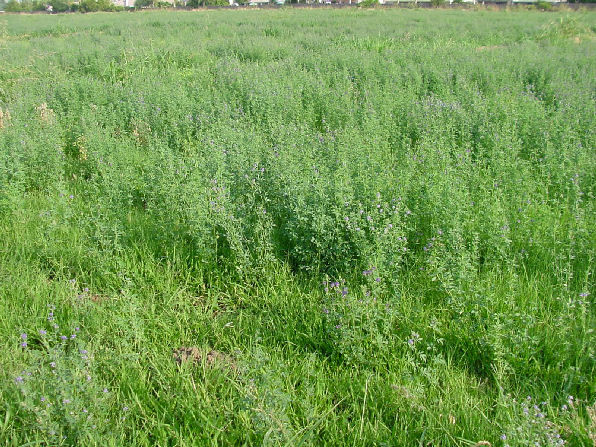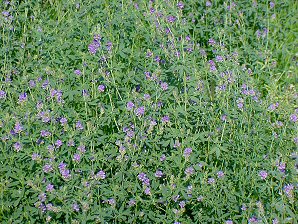Arizona Wild Flowers
Pictures, Photos, Images
Descriptions, Information, Reviews.
Alfalfa, Medicago sativa.
We Are Proud Of Our SafeSurf Rating!
Click On Any Of The Following Links By Amazon.Com
For Books, & Videos About Wildflowers Of Arizona & The Southwest USA. No Obligation!
 |
| Alfalfa, Medicago sativa - Photo Taken July 21, 2003 In Glendale. |
|---|
 |  |
| Summer Alfalfa Fields Bloom Gives A Slight Blue Color To The Lush Green Fields. | Alfalfa Flowers Bees Love Them! They Make Delicious Honey. |
|---|---|
 | |
| Alfalfa: Medicago sativa. | Close Up Of Alfalfa Flower. |
Alfalfa.
We wish to thank Wikipedia, the free encyclopedia for some of the information on this page. We share images and information with Wikipedia. Alfalfa can sometimes be seen growing wild in Arizona, so we are including it among our wildflowers of Arizona. Normally it is considered a cultivated agricultural crop; mainly for the feeding of livestock. Classed as an Annual or Perennial Alfalfa was introduced into the U.S. from southwest Asia. It is believed that over 3,000 years ago Medicago sativa was first cultivated in, and named for, the ancient country of Media (present northwest Iran). Like other members of the Bean or Pea Family alfalfa fixes Nitrogen with its roots, making it a valuable crop to rotate into fields, since it is a also a very common source of feed for many livestock. In the Phoenix area farmers can get up to 11 cuttings a year. One of the most interesting relationships is the relationship between honeybees and alfalfa. While honeybees will work the alfalfa fields they do not like to do so since they get hit by part of the flower when working the alfalfa blossom. Never the less, contrary to what the government agriculture people say, the honeybee will work alfalfa fields and they will very quickly fill bee hives with honey from alfalfa. A leaf cutter bee has been introduced into agriculture areas to help with alfalfa pollination, but it really is not necessary in my opinion. Here is that story. The alfalfa leafcutting bee was introduced into the United States from western Asia in the late 1930s for the commercial pollination of alfalfa plants. This bee is specially adapted for foraging on alfalfa flowers, which honey bees tend to avoid (if other nectar sources are available)(if not, then bees work alfalfa with eagerness). These small flowers must be pried open by the pollinating insect, which then gets dusted with pollen by the flower's spring-loaded anthers. The alfalfa leafcutting bee is managed intensively for alfalfa pollination in Washington, Oregon, California, Idaho, and Montana. Production of the bees is a multimillion dollar business in the United States and Canada, and it is also important in Russia.
Quick Notes:
Height: About 1 - 3 feet. Spreading out to about 2 foot wide.
Flowers: Alfalfa flowers are a brilliant blue color, irregular, about 1/4"-1/3" long, and found in elongated heads or spikes. The clusters of flowers themselves are about 1"-2" wide.
Flowering Time: March to October.
Leaves: The leaves are trifoliate, alternate, elongated, and end in a tiny hair-like point.
Found: Native to California, Nevada, Arizona and Utah, and in Mexico it is found in Baja California and Sonora.
Hardiness:
Soil pH requirements:
Sun Exposure:
Elevation: 0 - 4,500 Feet.
Habitat: On cultivated land, roadsides, yards. It also can be found in perennial fields.
Miscellaneous: Flowering Photos Taken July 21, 2003 In Glendale, Arizona.
|
We Are Proud Of Our SafeSurf Rating!
Click On Any Of The Following Links By Amazon.Com
For Books, & Videos About Wildflowers Of Arizona & The Southwest USA. No Obligation!
| © 1966 - Present, Audrey, Eve, & George DeLange |